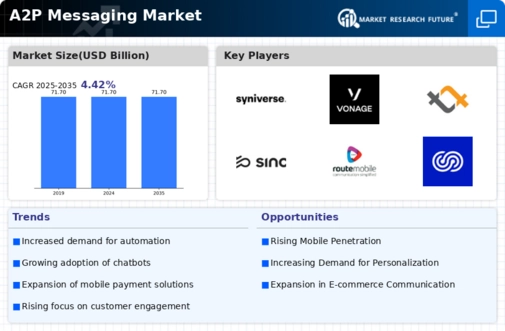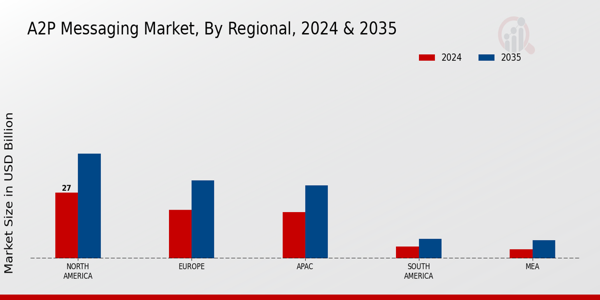Market Trends
Introduction
The A2P market is undergoing a radical transformation as we enter 2024. It is being driven by a combination of technological progress, heightened regulatory oversight and changing customer behavior. The proliferation of mobile devices and the rise of digital communication platforms are reshaping how businesses communicate with their customers, and this has prompted them to seek more efficient and personal communication solutions. Meanwhile, the growing regulatory focus on data privacy and security is compelling all players to adopt new strategies to ensure compliance while preserving customer trust. Then there is the way that customers’ expectations about immediate and seamless communication are driving businesses to use A2P as a critical component of their customer engagement strategies. These are the trends that need to be understood if the market is to be negotiated successfully.
Top Trends
-
Increased Regulatory Compliance
Governments are tightening their restrictions on A2P communication to fight spam and protect data privacy. The European Union’s General Data Protection Regulation, for example, has made it a requirement that recipients give their consent before a business can communicate with them. It is essential for companies to invest in compliance technology, which increases costs but also increases trust. And as the regulatory environment changes, companies may have to adapt their communication strategies to avoid incurring fines. This trend is likely to spur innovation in compliance solutions. -
Rise of Rich Communication Services (RCS)
RCS is a more inter-active alternative to SMS, allowing businesses to send multimedia messages. Major operators are investing in the technology and the rate of uptake is expected to reach 50 per cent by 2023. The transition will enable brands to engage more effectively with consumers, leading to higher conversion rates. As RCS becomes more commonplace, businesses will need to integrate it into their strategies if they want to stay ahead of the game. In the future, we may see improvements in the analytic capabilities. -
Integration of AI and Chatbots
AI-driven chatbots are increasingly being used to improve customer service. Twilio, for example, claims that its AI can reduce response times by up to 70%. This means that a company can engage with its customers around the clock, improving its customers’ experience and its own operational efficiency. As the capabilities of AI improve, companies will probably adopt more sophisticated solutions, enabling a more personalised service. And the future could see customer relations completely taken over by machines. -
Focus on Omnichannel Messaging
The omni-channel strategy is the key to the future of business. Surveys show that 75% of consumers prefer brands that use multiple communication channels. This trend is pushing companies to integrate A2P with email, social media, and other platforms. The operational impact is the need for a unified communication solution that can optimize communication. Future developments will include enhanced analytic capabilities to track performance across all channels. -
Enhanced Security Measures
In view of the increasing danger of cyber attacks, A2P service providers are prioritizing security features to protect users’ data. Reports indicate that 60 percent of companies have experienced a security breach in the past year. Two-factor authentication and end-to-end encryption are now used to protect the data. Not only do these features protect the users, but they also build up the reputation of the company. In the future, we may see the development of even more sophisticated security features to deal with new threats. -
Personalization and Targeted Messaging
Personalization of A2P messages is essential for effective customer engagement. Studies show that personalization increases the open rate by 26 percent. Business organizations are increasingly using data analytics to send messages based on the recipients’ behavior and preferences. This increases customer satisfaction and loyalty and drives repeat business. In the near future, with the development of technology, it will become the norm to send hyper-personalized messages. Real-time personalization will become a reality. -
Adoption of Cloud-Based Solutions
A2P solutions are gaining popularity, because of their scalability and cost-effectiveness. Leading companies like MessageBird report a 40% increase in the use of cloud services among their clients. It is a shift that enables businesses to run their campaigns more efficiently and reduce their operating costs. The more companies move to the cloud, the greater the demand for integrated communications platforms. Future developments may include improved collaboration and real-time data analysis. -
Growth of A2P Messaging in Emerging Markets
The increase in A2P communication is mainly due to the growth in mobile penetration and the digital transformation of emerging countries. For example, the use of instant messaging has increased by 30 per cent in Africa over the last year. This trend opens up new opportunities for companies to reach new customer bases. As mobile communication networks improve, the demand for A2P services will probably continue to grow. Localized solutions, tailored to the needs of the region, are to be expected in the future. -
Integration with IoT Devices
A2P messaging is increasingly combining with IoT devices, enabling devices to communicate with users in real time. By 2025, the number of IoT applications that use A2P is expected to reach 70 percent. This trend can help improve the user experience by providing users with timely information. In the future, as IoT applications increase, businesses will need to develop A2P applications that can meet the needs of this interconnected world. This will lead to more advanced automation in the IoT A2P space. -
Shift Towards Subscription-Based Models
Many of the A2P operators are now introducing subscription-based business models to make the cost of communications more predictable. This has resulted in a 25% increase in the use of subscription services by the messaging platforms. Subscription-based business models enable companies to budget more effectively and access premium services. Competition will intensify, and operators may need to be more inventive in order to retain customers. Subscription-based business models could develop further and offer a choice of different levels of service.
Conclusion: Navigating A2P Messaging's Competitive Landscape
The A2P Messaging Market in 2024 is characterized by a very high level of competition and significant fragmentation. The market is dominated by a large number of both established and new players. Regional trends show an increasing demand for localized solutions, influencing the strategies of vendors. The established players rely on their existing network and customer base, while the new players focus on innovation in the areas of artificial intelligence, automation and green solutions. To take advantage of the changing market, the vendors must be able to offer flexible and scalable solutions. The managers must therefore focus on these capabilities in order to respond to the complexity of the market and to seize emerging opportunities.

















Leave a Comment